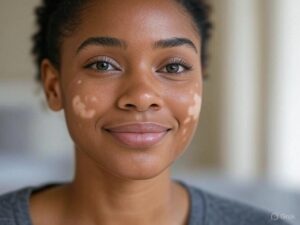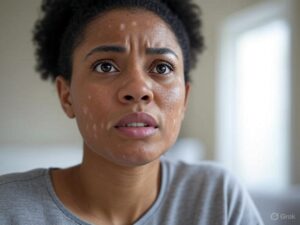
Painful Truths About 10 Common Skin Diseases and Infections Women Face (And How to Fix Them Fast)
Common skin diseases and infections in women are more than just surface-level concerns, they often affect self-esteem, comfort, and quality of life. From hormonal changes to environmental exposure, women face a unique set of challenges when it comes to skin health. Yet, many women quietly endure the discomfort, trying random creams or home remedies without knowing what’s really going on beneath the surface.
If you’ve struggled with itchy skin, stubborn breakouts, unexplained redness, or patches that just don’t fade, you’re certainly not alone. Many women experience these frustrating skin concerns, often without knowing the cause or the best way to treat them. This guide will help you understand these common skin problems, explaining why they occur and sharing effective solutions to finally bring relief.
We’ll explore the reasons behind these issues, from everyday irritants to underlying skin conditions, and provide practical advice on how to manage them. Whether it’s dryness, acne, or uneven skin tone, knowing the right steps can make all the difference. Let’s take a closer look at how to care for your skin and restore its natural balance.
The Impact of Healthy Skin on Confidence
1. Adult Acne in Women: The Breakouts That Won’t Quit
Acne is not limited to adolescence. Many women continue to experience breakouts well into their 20s, 30s, and even 40s. This stubborn skin concern is frequently triggered by hormonal changes, high stress levels, or unsuitable skincare routines. Unlike teenage acne, adult acne often appears in specific patterns and can be more challenging to manage.
Common Signs of Adult Acne:
-
Deep, tender cystic bumps concentrated along the jawline or chin
-
Clogged pores, including whiteheads and blackheads, particularly on the cheeks and forehead
-
Uneven skin texture with oily zones alongside dry, flaky patches, typical of combination skin
Why it happens:
-
Menstrual cycle changes
-
Polycystic ovary syndrome (PCOS)
-
Makeup or skincare that clogs pores
-
Stress or poor sleep
Solutions that work:
-
Use gentle, non-comedogenic skincare (products that won’t clog your pores)
-
Consider salicylic acid, benzoyl peroxide, or retinoids in your routine
-
Avoid over-washing or scrubbing the skin
-
In severe cases, speak to a dermatologist for tailored treatments
For trusted skincare backed by dermatologists, visit CeraVe, a brand known for effective and skin-friendly solutions.
2. Fungal Infections: The Silent Itch You Can’t Ignore

One of the most common skin infections in women, especially in hot or humid climates, is a fungal infection. These thrive in moist areas and often occur in folds of the skin, under the breasts, or between the thighs.
What it looks like:
-
Red patches with clear edges
-
Itching or burning sensation
-
Peeling or cracked skin
Why it happens:
-
Tight or damp clothing
-
Sweating without proper hygiene
-
Poor air circulation in skin folds
How to deal with it:
-
Keep the affected area clean and dry
-
Wear breathable cotton underwear and loose-fitting clothes
-
Use antifungal creams containing clotrimazole or miconazole
-
Avoid sharing towels or personal items
This is a condition that can be easily treated, but if ignored, it can become chronic or spread. The NHS offers more details on treatment at nhs.uk/conditions/fungal-skin-infection.
3. Eczema: The Flare-Up That Feels Like Fire

Eczema, also known as atopic dermatitis, is a long-term skin condition that leads to dry, irritated, and itchy patches on the skin. Many women first develop eczema in childhood, and it can persist into adult life. Flare-ups often become more severe during pregnancy or times of high stress.
Common signs of eczema include:
-
Dry, flaky skin that feels very itchy
-
Red, swollen patches which may sometimes crack or bleed
-
In more serious cases, blisters or weeping skin may appear
Why it happens:
-
Genetics
-
Allergens like pollen or dust
-
Harsh soaps and perfumes
-
Emotional stress
How to calm it down:
-
Use fragrance-free moisturisers and soaps
-
Keep your nails short to avoid breaking the skin from scratching
-
Apply thick moisturiser after every bath or shower
-
In some cases, topical steroids prescribed by a doctor may be needed
Avoiding triggers is key. Also, try using a humidifier at night if your room is dry.
4. Melasma: The Mask of Pregnancy That Stays
Melasma is a common skin condition characterised by patches of hyperpigmentation, typically triggered by hormonal changes. While it frequently develops during pregnancy, earning it the nickname “the mask of pregnancy, it can persist long after childbirth. Additionally, women taking oral contraceptives or those with thyroid imbalances may also experience melasma.
Appearance and Common Features:
-
Irregular brown or greyish-brown patches, often appearing on sun-exposed areas of the face
-
Most frequently affects the cheeks, forehead, bridge of the nose, and upper lip
-
Typically presents symmetrically, forming matching patterns on both sides of the face
Why it happens:
-
Hormonal changes
-
Sun exposure
-
Genetic factors
Best ways to lighten it:
-
Always use a broad-spectrum SPF 30 or higher
-
Try products with niacinamide, kojic acid, or azelaic acid
-
Limit direct sun exposure, especially midday
-
Consider seeing a dermatologist for chemical peels or prescription creams
Even though it’s harmless, melasma can make many women feel self-conscious. Wearing a wide-brimmed hat and using mineral sunscreen daily can make a big difference over time.
5. Bacterial Infections: The Spots You Shouldn’t Pop
Not every bump on the skin is a harmless pimple. Some may be bacterial infections, particularly if they feel tender, warm, or begin to swell. These infections require careful attention to prevent complications.
Common types in women include:
-
Folliculitis: infection of the hair follicle
-
Boils or abscesses: deep pus-filled lumps
-
Impetigo: highly contagious yellowish sores, often around the nose or mouth
How it spreads:
-
Poor hygiene or shaving with dirty razors
-
Skin-to-skin contact
-
Sharing personal care products
How to prevent and treat it:
-
Refrain from shaving over irritated or inflamed skin to avoid spreading bacteria.
-
Always use sanitized razors and fresh towels to minimize infection risks.
-
Apply prescribed antibiotic ointments, such as fusidic acid, to combat bacterial growth.
-
Consult a doctor if the infection worsens, as untreated cases may need medical intervention.
If untreated, bacterial infections can spread quickly. Early attention is always the best approach.
6. Skin Tags and Warts: Harmless But Annoying
While not dangerous, skin tags and warts are among the most frustrating skin conditions women deal with—especially when they appear in visible or uncomfortable places.
What they look like:
-
Skin tags: small, soft flaps of skin, usually found around the neck, underarms, under breasts, or groin area
-
Warts: rough, raised bumps, sometimes with a black dot in the centre
Why they happen:
-
Friction from clothing or jewellery
-
Hormonal changes during pregnancy or middle age
-
Viral infections like the human papillomavirus (HPV), especially for warts
How to get rid of them:
-
Don’t cut or pull them off, they can bleed or get infected
-
Over-the-counter treatments (especially for warts) can help
-
Cryotherapy (freezing) or minor procedures at a skin clinic are safe and fast
-
Keep the areas clean and dry to prevent growth
If you’re unsure whether a bump is a wart or something more serious, it’s best to get it checked by a dermatologist.
7. Psoriasis: When Your Skin Won’t Stop Shedding
Psoriasis is a condition where the body’s immune system makes skin cells grow too quickly. This leads to thick, red patches covered with silvery scales. It can feel uncomfortable and sometimes upsetting, particularly when flare-ups happen at inconvenient moments.
What it looks like:
-
Thick patches of red skin with white or silver scales
-
Common on elbows, knees, scalp, and lower back
-
Itching, cracking, and sometimes bleeding
Why it happens:
-
Genetics play a big role
-
Triggers include stress, cold weather, smoking, or certain medications
-
Immune system mistakenly attacks healthy skin cells
Helpful Ways to Manage Psoriasis:
-
Apply rich, unscented moisturisers to keep skin from drying out
-
Choose gentle soaps and avoid very hot water when bathing
-
Some people find light therapy useful, but always check with a doctor first
-
Stronger treatments, like medicated creams or injections, might be needed for severe psoriasis
It’s not contagious, but it can be emotionally exhausting. Support groups and mental health check-ins are just as important as creams when dealing with long-term skin conditions like this.
8. Contact Dermatitis: That Rash From Your New Perfume
Have you ever worn a new lotion or perfume and suddenly broken out in a rash? That’s likely contact dermatitis, a skin reaction to something your skin doesn’t agree with.
What it looks like:
-
Red, itchy rash that appears hours or days after contact
-
Swelling, burning, or blisters in more serious cases
-
Often appears where the product was used (e.g., neck, wrists, arms)
Why it happens:
-
Reaction to ingredients in perfumes, soaps, hair dyes, or even jewellery
-
Nickel (in costume jewellery), latex, and some preservatives are common triggers
-
Sensitivity can develop even after years of using the same product
How to treat and prevent it:
-
Stop using the suspected product immediately
-
Wash the area gently with lukewarm water
-
Use over-the-counter hydrocortisone cream or oral antihistamines
-
Choose hypoallergenic products for future use
Patch testing by a dermatologist can also help you find out exactly what your skin reacts to so you can avoid it in the future.
9. Building a Skin Routine That Actually Works for You
The truth is, many women experience skin issues not because their skin is “bad,” but because they’re using products that don’t suit them, or using too many things at once.
Start with the basics:
-
Cleanser: Use a gentle one, especially if your skin is sensitive or acne-prone
-
Moisturiser: Every skin type needs one, even oily skin
-
Sun protection: A broad-spectrum SPF 30 or higher is non-negotiable
-
Night care: At night, include treatments like retinoids or serums based on your specific concerns (wrinkles, acne, dark spots, etc.)
Be mindful of this:
-
Don’t switch products too often; your skin needs time to adjust
-
Always patch test new products on a small area before full use
-
Hydrate well, eat whole foods, and try to sleep well skin reflects your lifestyle
And remember: more products do not mean better skin. Consistency, simplicity, and patience work wonders.
10. When to See a Dermatologist (And Why You Should)
Many women put off visiting a skin specialist, often dismissing their concerns as not being “serious enough.” However, if something on your skin is causing you worry, affecting how you feel about yourself, or simply isn’t improving with regular care, it’s important to seek professional advice.
You should consider booking an appointment with a dermatologist if you observe any of the following:
-
Moles or dark spots that change suddenly in size, shape, or colour.
-
Rashes or irritation that linger for a long time without getting better.
-
Persistent acne or noticeable scarring that bothers you.
-
Unusual lumps that are painful or signs of infection that seem to be spreading.
-
Patches of discoloured or rough skin without any clear reason.
Getting expert help early can make a big difference not only in preventing further skin damage but also in helping you feel happier and more confident in your own skin. Don’t wait until it feels like a bigger problem; your skin’s health matters.
Read Also: Why Virgin Hair Fertilizer is a Game-Changer for Damaged Hair
Tips for Preventing Common Skin Diseases and Infections
- Stay clean: Wash your face and body daily to remove sweat, dust, and bacteria.
- Choose safe products: Avoid skin-lightening creams with harmful chemicals like mercury or steroids.
- Wear breathable clothing: Opt for cotton fabrics to reduce sweat and fungal growth.
- Protect from the sun: Use sunscreen and hats to prevent melasma and sun damage.
- Avoid sharing personal items: Towels, makeup brushes, or razors can spread infections like impetigo or ringworm.
- Eat well: A diet rich in fruits, vegetables, and water supports healthy skin.
By following these tips, you can lower your risk of skin problems and keep your skin looking its best.
Making Skincare a Daily Habit
You Deserve Healthy Skin That Feels Like You
Having skin issues doesn’t make you dirty, careless, or weak, it makes you human. The most important thing is to take your skin seriously and give it the same attention you give your hair, clothes, or fitness.
Spotting the signs early, understanding what causes them, and picking the best fixes, like a gentle moisturiser, a special cream from the doctor, or even expert advice, puts you on the right track.
If you’ve read this far, it shows how much you want to look after your skin. And that effort will always be worth it!
Would you like a handy skincare checklist to print out? Or maybe an easy starter routine to help you begin? Just let me know!


